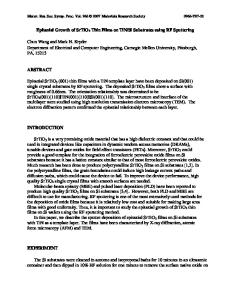AFM, XPS and XRD Studies of W Films Growth by Lpcvd Onto Tin Substrates
- PDF / 1,894,535 Bytes
- 6 Pages / 414.72 x 648 pts Page_size
- 33 Downloads / 256 Views
ABSTRACT Thin films of W were grown using the low pressure chemical-vapour deposition technique in WF 6/SiH 4 flow on a TiN layer obtained by annealing in nitrogen atmosphere Ti films for different times. The investigation of W nucleation was followed by Atomic Force Microscopy in air. The Atomic Force images taken after fixed time of exposure of the TiN layer to the WF 6 /SiH 4 flow show, on the surface of the W films, the presence of columnar structures only when the TiN films were obtained with forming times below 100 minutes. To investigate this effect X-ray Photoelectron Spectroscopy depth profile and X-Ray Diffraction measurements were performed on the obtained W/TiN films. The results show the deeper penetration of the nitrogen into the titanium layer with the longer forming time and a non stoichiometric composition of TiN interfacial layer which strongly influences the W nucleation. INTRODUCTION Tungsten offers so much advantages for using as contact and via fills in the development of ultra large scale integrated (ULSI) circuits' that the microelectronics industry has shown an increasing interest in developing chemical vapour deposition (CVD) processes for W deposition. In the last years much research effort has been devoted to understand the kinetics 2-5 of low pressure chemical-vapour deposition (LPCVD) of tungsten, using tungsten hexafluoride (WF 6 ) and silane (Sil 4 ) as precursors, as well as the mechanical and micro-structural properties of the tungsten films 6 ,7 . However the chemistry of this process is aggressive towards most of insulator films, such as silicon oxide, phosphosilicate glass (PSG) or borophosphosilicate glass (BPSG) and the thickness uniformity and the adhesion of the tungsten film are poor 8 . Therefore, the use of a TiN film has been proposed 9 as a conductive adhesion layer and as a barrier to prevent defects which are caused by the tungsten diffusion or fluorine penetration during the film deposition. TiN layers were grown by CVD 10 or by reactive sputtering of Ti in N 2/Ar atmosphere 1 1, while the reaction of Ti on the doped silica films with nitrogen ambient gained considerable interest in integrated circuit manufacturing 1 2,13 . Even if a considerable effort has been done to study the W growth onto TiN substrates 14 -16 we have no notices of systematic investigations on the micro-structural and morphological properties of the grown layers. In this work the early stages of W growth by the reduction of WF 6 using Sil 4 onto TiN layers, obtained by sputtering Ti and nitridating it in a N2 /H2 flow with different forming times, were carefully studied by the Atomic Force Microscopy (AFM) to observe how these conditions influence the morphology of the W layer. This knowledge is of straightforward importance for any sub micron device process because the growth defects at the W/TiN interface affect the roughness and therefore the thickness homogeneity of the whole W layer. The insufficient homogeneity of the W film reduces the coverage on the sub micron features, particularly nea
Data Loading...








